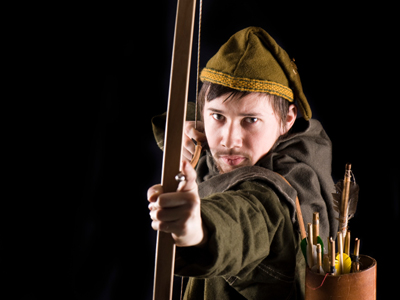
Ask the AI Tutor
Need help with Crime And Punishment: The Middle Ages? Ask our AI Tutor!
AI Tutor - Lucy
Connecting with Tutor...
Please wait while we establish connection

Robin Hood was a myth made up by people craving justice.
Crime And Punishment: The Middle Ages
Medieval crime and punishment could be harsh, but it followed strict rules. This quiz explores laws, trials, and penalties in the Middle Ages.
1 .
Between 1195 and 1361 the magistrate system developed. By what name were they usually known?
Guardians of the Peace
Trustees of the Peace
Guarantors of the Peace
Justices of the Peace
The 1327 statute, for example, was looking for "good and lawful men" in every county to fulfil this task
2 .
The mythology of Robin Hood centres on his role as a man of the people securing justice for the poor. Which of the following was not a member of his circle in Sherwood Forest, Nottinghamshire?
John Ball
Alan-a-Dale
Will Scarlett
Little John
Similar myths gathered around his followers
3 .
Islamic (Sharia) Law generally considered apostasy to be deserving of the death penalty. What was apostasy?
Encouraging Muslims to embrace another faith
Embracing another faith oneself
Criticising the Prophet Mohammed
Damaging a copy of the Holy Koran
Some Islamic scholars disagreed with this interpretation of the Prophet's words - either in the Koran itself or the Hadith
4 .
Under what form of law could ordinary citizens be dealt with for marriage, tithe, wills and magic offences?
Monastic Law
Sacerdotal Law
Canon Law
Theocratic Law
These matters would often today be regarded as private. But in the Middle Ages religious and family affairs could be issues for the law
5 .
What was the most drastic medieval penalty for female adulterers?
The ducking stool
The stocks
Drowning
Whipping
Women who had committed a moral offence were almost always treated more harshly than equivalent men
6 .
In 855 Ethelwulf permitted English churches to levy the tithe (set at 10% of income or profit). The legal validity of tithes was confirmed by the Statute of Westminster in 1285. Which one of the following groups was obliged to pay the tithe?
The King
Rectors (to the vicar)
Vicars (to the rector)
Freemen
Tithe barns were erected to hold the produce collected
7 .
An early principle of Anglo-Saxon justice was that justice in the face of crime was the responsibility of the local community, and of which other group?
The victim's friends
The victim's family
The local thegns (low ranking nobles)
All members of the community who have acquired criminal convictions
The sense of responsibility was very strong: these were local matters, to be resolved locally
8 .
Medieval laws compelled all able-bodied men witnessing a crime to chase the offender until he was caught - even if the chase was long and ended up in a different town or county. What was this process called?
Hue and cry
Hot Pursuit
Paperchase
Broadcast
As there was no police force, the job of catching criminals on the run fell to local able-bodied men
9 .
Which were the lowest in the pecking order of medieval courts?
Hundred courts
Leet courts
Manorial courts
Wapontake courts
These courts dealt with matters such as local contracts and land tenure
10 .
Which one of the following was not a form of trial by ordeal up to 1215?
Water
Combat
Fire
Ice
With its origins in Anglo-Saxon times, trial by ordeal persisted well into the Middle Ages
**Unlimited Quizzes Await You! 🚀**
Hey there, quiz champ! 🌟 You've already tackled today's free questions.
Ready for more?
Ready for more?
🔓 Unlock UNLIMITED Quizzes and challenge yourself every day. But that's
not all...
not all...
🔥 As a Subscriber you can join our thrilling "Daily Streak" against other
quizzers. Try to win a coveted spot on our Hall of Fame Page.
quizzers. Try to win a coveted spot on our Hall of Fame Page.
Don't miss out! Join us now and keep the fun rolling. 🎉
**Unlimited Quizzes Await You! 🚀**
Hey there, quiz champ! 🌟 You've already tackled today's free questions. Ready for more?
🔓 Unlock UNLIMITED Quizzes and challenge yourself every day. But that's not all...
🔥 As a Subscriber you can join our thrilling "Daily Streak" against other quizzers. Try to win a coveted spot on our Hall of Fame Page.
Don't miss out! Join us now and keep the fun rolling. 🎉






